Jag startade min första blogg 2006. Detta enda beslut förändrade allt – det öppnade dörrar och ledde så småningom till att jag skapade WPBeginner, som nu är världens största kostnadsfria WordPress-resurssajt.
Jag heter Syed Balkhi och genom åren har jag byggt upp flera framgångsrika bloggar – några av dem genererar nu en sjusiffrig inkomst. Bloggar har helt förändrat mitt liv, och jag tror att det kan göra detsamma för dig.
Om du funderar på att starta en blogg behöver du inte ta reda på det på egen hand. I den här guiden kommer jag att berätta exakt hur jag går tillväga när jag startar en ny blogg. Jag kommer att gå igenom allt, ett steg i taget.
Du kommer också att få personliga tips som jag har lärt mig under många års erfarenhet av bloggande – den typ av råd som jag önskar att någon hade gett mig när jag precis hade börjat.
Oavsett om du vill blogga som ett kreativt utlopp, en sidosyssla eller ett företag är den här guiden din startpunkt – och du börjar med erfarenheten från en framgångsrik bloggare vid din sida.
Låt oss få din blogg online – och ta det första steget tillsammans.
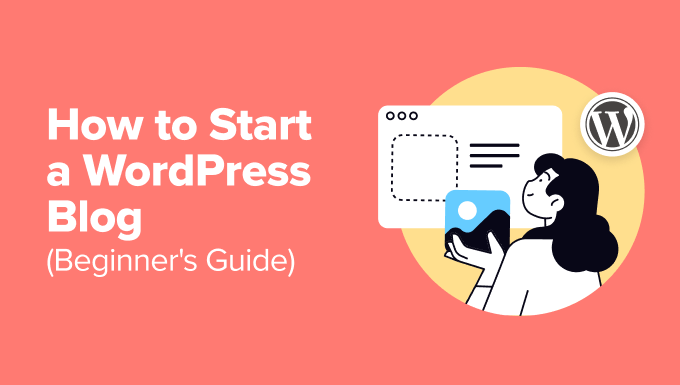
Är du lite nervös inför att starta din första blogg? Jag lovar att processen är lätt att följa, oavsett om du är 20 eller 60 år gammal. Men om du behöver extra vägledning kan mitt expertteam hjälpa dig att starta din blogg helt gratis. → Klicka här för att få din kostnadsfria WordPress-blogg! ←
Vad är en blogg (och varför du bör starta en redan idag)
Innan vi går in på stegen vill jag ta en stund och prata om vad en blogg egentligen är – och varför det kan vara det bästa beslutet du tar i år att starta en.
En blogg är en typ av webbplats där du regelbundet publicerar innehåll, vanligtvis i form av artiklar eller uppdateringar. Du kan använda den för att dela med dig av dina tankar, lära ut något, berätta historier, recensera produkter eller till och med driva ett företag.
När jag startade min första blogg 2006 insåg jag inte riktigt vilken inverkan den skulle få.
Det började som ett sätt att dela med mig av det jag lärde mig, och med tiden öppnades dörrar som jag aldrig hade förväntat mig – bland annat att göra bloggandet till en heltidsverksamhet.
Det är det fina med att blogga. Det handlar inte bara om att skriva. Det är ett sätt att få kontakt med människor, bygga upp något eget och skapa verkliga möjligheter.
Oavsett om du vill blogga för att få utlopp för din kreativitet, skaffa dig en sidoinkomst eller bygga upp en seriös närvaro på nätet – allt börjar på samma sätt.
Du publicerar ditt första inlägg. Du fortsätter. Och lite i taget förvandlas din blogg till något kraftfullt. 📈
I stegen som följer kommer jag att visa dig exakt hur jag skulle starta en blogg idag – med samma process som jag har följt för att starta flera framgångsrika bloggar. Du kommer att få mina personliga tips, verktyg och lärdomar i varje steg.
Och det bästa av allt? Du behöver inte vara en teknisk expert eller en professionell skribent för att komma igång. Allt du behöver är ett ämne du bryr dig om och viljan att börja.
- Step 1: Picking the Right Blog Niche
- Step 2: Getting Started With Your Blog
- Step 3. Install WordPress Blogging Software
- Step 4: Customizing Your Blog
- Step 5: Writing Your First Blog Post ✍️
- Step 6: Adding Essential Plugins 🔌
- Step 7: Growing Your Blog Audience
- Step 8: Making Money From Your Blog 💰
- Step 9: Mastering WordPress
- Bonus Tip: Explore Niche Blogging Resources
- Frequently Asked Questions About Blogging (FAQs)
- Video Tutorial
- Final Thoughts
Är du redo? Låt oss komma igång.
💡 Kämpar du med att skapa en blogg? WPBeginner Pro Services kan göra din drömblogg till verklighet! Våra experter på WordPress-utveckling kommer att ta fram en anpassad design, inklusive en skräddarsydd hemsida och fem mallar för undersidor – allt till ett överkomligt pris. Få våra tjänster för WordPress-webbplatsdesign idag!
Steg 1: Välja rätt bloggnisch
Ett av de första besluten du fattar är att välja din bloggnisch – det huvudsakliga bloggämne du kommer att skriva om.
Jag får hela tiden frågan “Vad ska jag blogga om?” Mitt svar är enkelt: börja med något du bryr dig om. Om du brinner för det kommer du att njuta mycket mer av processen – och det kommer dina läsare också att känna.
När jag startade WPBeginner fokuserade jag på WordPress. Jag älskade att hjälpa människor att lära sig det, och det gav min blogg en tydlig riktning. Det var den passionen som fick mig att fortsätta – även när det inte var lätt.
Din nisch kan vara en hobby, en färdighet du har lärt dig eller till och med något du vill lära dig mer om. Känn inte att du måste vara expert – var bara villig att dela med dig av det du vet och fortsätt att lära dig på vägen.
Om du är osäker på vad du ska välja, fråga dig själv:
- Vilka ämnen tycker jag om att läsa eller prata om?
- Vilka erfarenheter eller kunskaper kan jag dela med mig av till andra?
- Är det här något jag kan skriva om regelbundet utan att bli uttråkad?
- Kan det här ämnet utvecklas till ett företag eller locka en publik?
Oroa dig inte för att välja den “perfekta” nischen den första dagen. Det som betyder mest är att börja med något som gör dig upphetsad. Du kan alltid förfina det när din blogg växer.
💡 Bonus Tips: Mitt team sammanställde en lista över populära bloggnischer som tjänar pengar. Om du behöver inspiration är det ett bra ställe att utforska idéer.
Steg 2: Kom igång med din blogg
Jag har sett många användare som startar sin första blogg med hjälp av en gratis plattform. Det känns som det enklaste alternativet just då, men det tar inte lång tid innan de drabbas av begränsningarna.
Du kunde inte anpassa designen, lägga till funktioner eller ens äga ditt innehåll fullt ut.
Det är där WordPress kommer in i bilden.
WordPress gav mig full kontroll. Jag kunde utveckla min webbplats, tjäna pengar på den hur jag ville och bygga upp ett riktigt företag.
Det är samma plattform som jag använde för att skapa WPBeginner, och det är vad jag rekommenderar till alla som vill starta en blogg på rätt sätt. För mer information, ta en titt på min fullständiga WordPress.org-recension.
Här är varför jag rekommenderar att du startar din blogg med WordPress.org:
- Det är gratis och öppen källkod
- Du behöver inte ha kodningskunskaper
- Du äger helt och hållet ditt innehåll och din webbplats
- Du kan tjäna pengar på det på vilket sätt du vill
För att komma igång med WordPress.org behöver du bara tre saker:
- Ett domännamn – Det här är namnet på din blogg (t.ex. wpBeginner.com).
- Webbhotell – Det är här som bloggfilerna lagras.
- 30 minuter av din tid – det är allt som krävs för att starta din blogg idag.
Ett domännamn kostar vanligtvis $14,99/år, och hosting börjar runt $7,99/månad. Det kan bli en hög summa – särskilt när du precis har kommit igång.
Det är därför jag rekommenderar Bluehost – ett webbhotell som jag personligen använder och litar på.
Bluehost har arbetat med WordPress sedan 2005 och är värd för miljontals webbplatser. Med Bluehost får du:
- Prisvärd hosting med gratis domännamn
- Snabba servrar och generöst med lagringsutrymme
- 24/7 kundsupport från WordPress-experter
- Upp till 83% rabatt med min Bluehost-kupong
För mer information, kolla in min fullständiga Bluehost-recension.
Om du följer den här guiden och inte kan få din blogg online inom 30 minuter, kommer mitt team att sätta upp den åt dig gratis. Kontakta oss bara med hjälp av vår kostnadsfria tjänst för blogginställningar.
ℹ️ OBS: Om du registrerar dig med hjälp av min referenslänk får jag en liten provision utan extra kostnad för dig. Faktum är att du sparar pengar och får en gratis domän som en del av erbjudandet.
För att komma igång öppnar du Bluehost i en ny flik och klickar på den gröna knappen “Kom igång nu”.
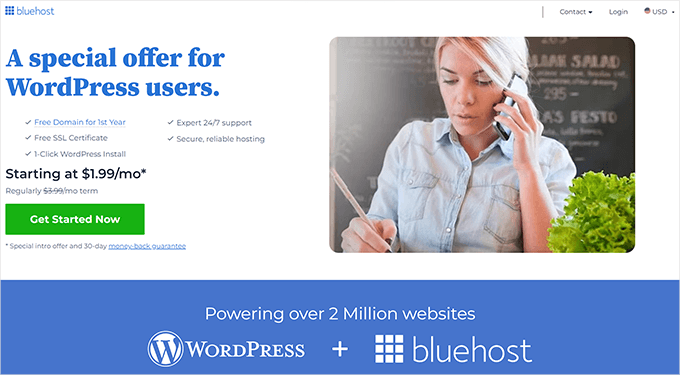
Välj den hostingplan du vill ha. Basic och Choice Plus är de mest populära alternativen.
Därefter väljer du ditt domännamn.
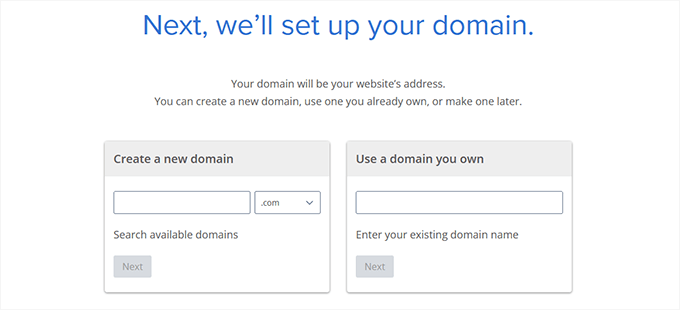
Fyll i dina kontouppgifter och slutför ditt paket. Jag rekommenderar att du väljer 12-månadersplanen för att få det bästa värdet.
Du ser tillvalstjänster på kassasidan. Du behöver inte dem just nu – du kan alltid lägga till dem senare om det behövs.
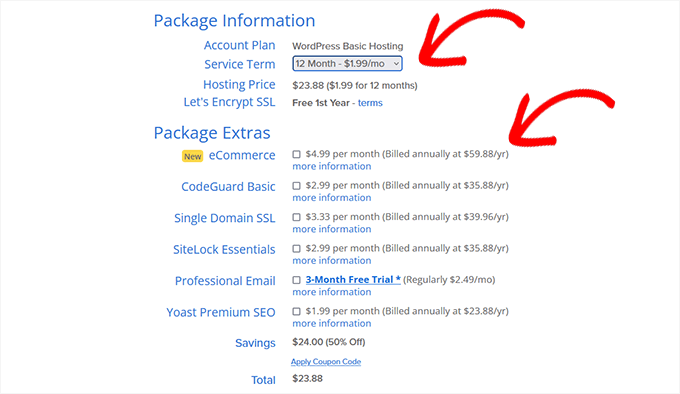
När ditt köp är slutfört skickar Bluehost dina inloggningsuppgifter via e-post. Du använder dessa för att komma åt kontrollpanelen för ditt webbhotell(kallad cPanel), där du hanterar din webbplats och installerar WordPress.
Steg 3. Installera WordPress programvara för bloggning
När du registrerar dig hos Bluehost via min länk installerar de automatiskt WordPress åt dig så att du kan börja bygga din blogg omedelbart.
Logga bara in på ditt Bluehost-konto och klicka sedan på knappen “Redigera webbplats” för att komma igång.
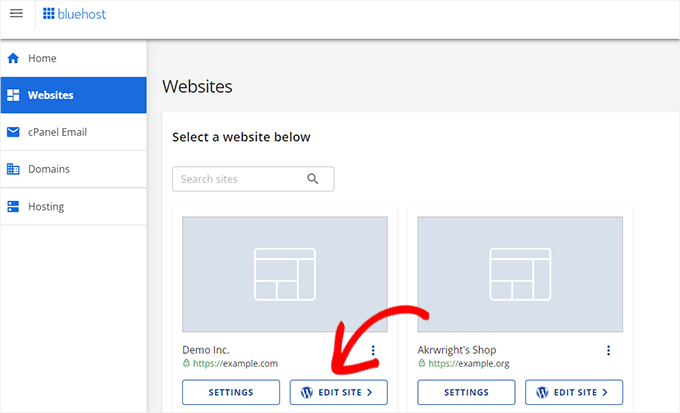
Du kan också logga in på WordPress genom att gå till yoursite.com/wp-admin/ direkt från din webbläsare.
Om du använder en annan värdtjänst för WordPress-bloggar, t.ex. SiteGround, Hostinger, DreamHost eller andra, kan du se min guide om installation av WordPress för steg-för-steg-instruktioner för dessa leverantörer.
Med det sagt har jag märkt att de flesta av de ovanstående webbhotellföretagen nu automatiskt installerar WordPress för att hjälpa icke-tekniska användare att starta sin bloggresa.
När WordPress är installerat är du redo att skapa dina bloggsidor, anpassa bloggens design och börja blogga.
Steg 4: Anpassa din blogg
När jag startade min första blogg ägnade jag timmar åt att försöka få den att se perfekt ut. Jag var inte den bästa formgivaren, så jag experimenterade med olika teman, färger och layouter.
Det kändes överväldigande till en början, men jag insåg snabbt att enkelhet var nyckeln till en bra bloggdesign.
Din bloggs design är som ansiktet på din webbplats. Det är det första besökarna lägger märke till och sätter tonen för deras upplevelse. Med WordPress är det enkelt att skapa en professionell design utan att behöva kunna koda.
WordPress-teman styr hur din blogg ser ut. När du först installerar WordPress kommer din blogg att se ut så här:
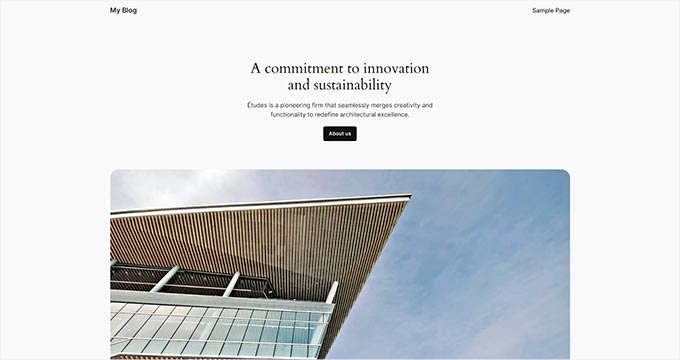
Oroa dig inte om det inte är vad du föreställde dig. WordPress erbjuder tusentals gratis- och premiumteman för att helt förändra utseendet på din blogg.
För att komma igång går du till din WordPress-panel och klickar på Utseende ” Teman. Klicka sedan på knappen “Lägg till nytt tema”.
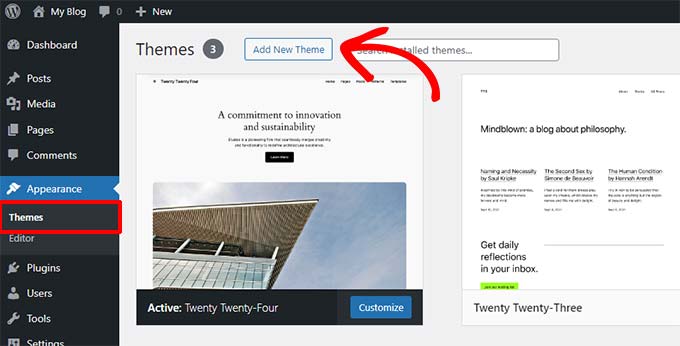
Du hittar över 7 000 kostnadsfria teman i WordPress.org-katalogen. Du kan filtrera dem efter populära, senaste eller specifika funktioner.
Håll muspekaren över ett tema för att se en förhandsgranskning som visar hur det kan se ut på din webbplats.
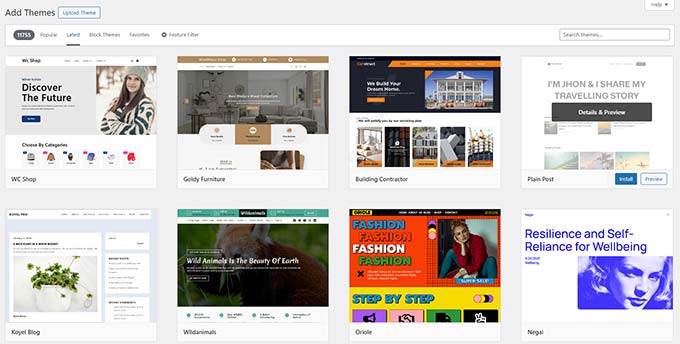
Kom ihåg att förhandsgranskningen inte blir perfekt förrän du anpassar den senare.
När du hittar ett tema som du gillar klickar du bara på “Installera”. När du har installerat klickar du på “Aktivera” för att få det att fungera på din webbplats.
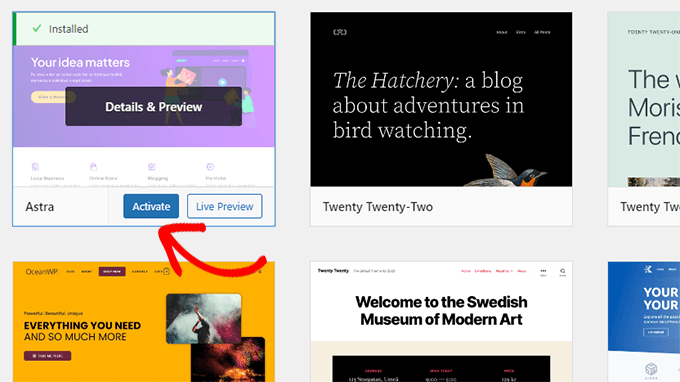
Tidigt i min bloggresa insåg jag att mindre är mer när det gäller design. En ren och enkel blogg ser inte bara bättre ut utan gör det också lättare för läsarna att hitta det de letar efter.
När ditt tema är aktivt kan du gå till Utseende ” Anpassa för att justera färger, teckensnitt och layouter. Du kan även lägga till din logotyp för att göra din blogg unik.
Om du använder ett blocktema hittar du redigeraren under Utseende ” Redaktör.
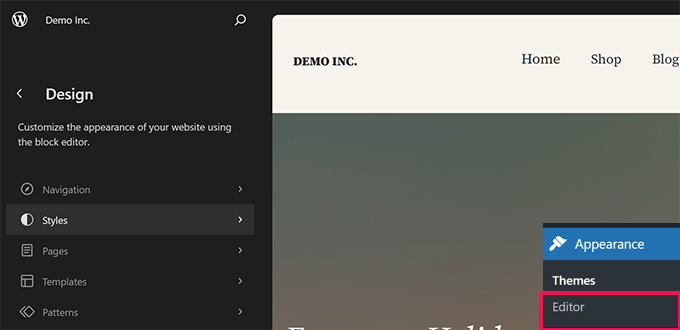
För ännu mer kontroll rekommenderar jag att du använder en sidbyggare som SeedProd eller Divi.
Jag har SeedProd på många av mina företagswebbplatser och bloggar. Du kan läsa mer om det i min detaljerade recension av SeedProd.
Dessa verktyg kallas sidbyggare och erbjuder intuitiva dra-och-släpp-gränssnitt för att skapa anpassade designer. Du kan skapa egna sidhuvuden, sidfötter och layouter utan att skriva någon kod.
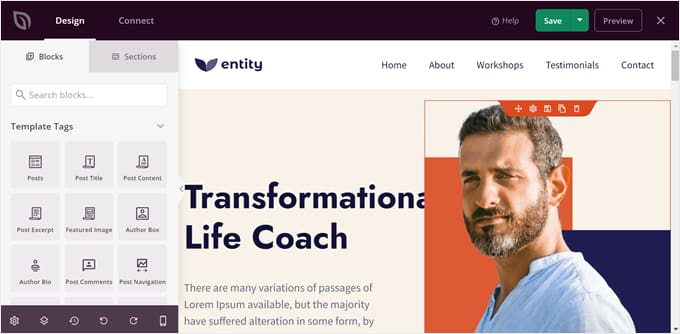
Om du inte vet var du ska börja kan du kolla in min guide om hur du väljer det perfekta WordPress-temat. Håll din design ren och användarvänlig så kommer du att få en bra start.
När din design känns rätt är du redo att börja skapa innehåll!
Steg 5: Skriva ditt första blogginlägg ✍️
När jag skrev mitt första blogginlägg hade jag ingen aning om hur stort genomslag det skulle få. Jag tillbringade timmar med att skriva om det och försöka göra det perfekt.
Så här i efterhand önskar jag att jag bara hade fokuserat på att få den publicerad. Det viktigaste steget är att börja, och WordPress gör det enkelt att göra just det.
För att skriva ditt första inlägg går du till din WordPress-panel och klickar på Inlägg ” Lägg till nytt. Då öppnas redigeringsverktyget där du kan börja skriva ditt innehåll.
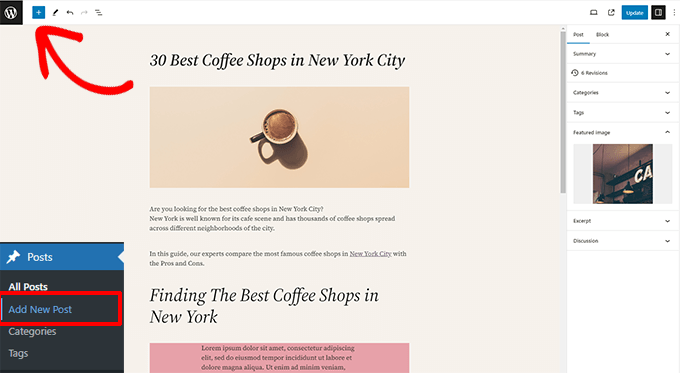
WordPress använder en blockbaserad editor som låter dig skapa vackra layouter för dina inlägg. Det är enkelt att använda och otroligt flexibelt.
Kolla in denna kompletta WordPress block editor tutorial om du behöver hjälp med att bekanta dig med redigeraren.
När du har skrivit ditt inlägg klickar du på knappen “Publicera” i det övre högra hörnet. Det var det – ditt blogginlägg är live!
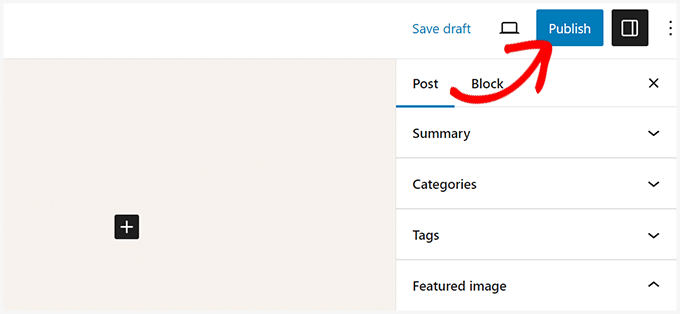
När du skriver kommer du att märka avsnitt som Kategorier och Taggar på inläggsskärmen. Dessa hjälper dig att organisera ditt innehåll. Jag rekommenderar att du läser vår guide om skillnaden mellan kategorier och taggar för att använda dem effektivt.
För att få ut mesta möjliga av WordPress funktioner kan du kolla in vår detaljerade guide om hur du lägger till ett nytt inlägg. Den täcker allt från inbäddning av videor till att lägga till rubriker, punktlistor och uppmaningsknappar.
Om du har svårt att komma på idéer till ditt första inlägg, oroa dig inte. Många nya bloggare, inklusive jag själv, står inför denna utmaning. Här är några användbara resurser:
- Gratis verktyg för attgenerera idéer till blogginlägg av WPBeginner
- 130+ idéer till blogginlägg som dina läsare kommer att älska
- 50 typer av bloggämnen som bevisligen fungerar
- Så här skriver du ett bra blogginlägg (struktur + exempel)
- Så här skapar du en effektiv plan för content i WordPress
Jag använder också sökordsforskning för att hitta ännu fler bloggidéer. Det hjälper ditt innehåll att rankas högre i sökmotorer och locka fler läsare. Jag har skrivit en steg-för-steg-guide om hur man gör sökordsforskning med samma metoder som jag använder för WPBeginner.
Mitt råd till dig? Sikta inte på perfektion med ditt första inlägg. Börja bara skriva och tryck på publicera. Ju tidigare du börjar, desto snabbare kommer du att lära dig och växa som bloggare.
Steg 6: Lägga till viktiga insticksprogram 🔌
När jag först började blogga ville jag att min webbplats skulle göra mer än att bara publicera inlägg. Jag ville ha kontaktformulär, e-postlistor och andra funktioner som kunde hjälpa mig att få fler läsare.
Det är där plugins kommer in i bilden. De är som appar för din WordPress-webbplats. De låter dig lägga till kraftfulla funktioner på din webbplats utan att du behöver några tekniska färdigheter.
Idag finns det över 59.000 gratis plugins i WordPress-katalogen, så det finns ett plugin för nästan allt du kan tänka dig. Mer information finns i den här artikeln om WordPress-plugins och hur de fungerar.
Om du inte är van vid plugins behöver du inte oroa dig. Mitt team har skapat en steg-för-steg-guide om hur du installerar ett WordPress-plugin.
Låt oss nu titta på några viktiga plugins som varje blogg bör ha. Jag kommer att dela med mig av mina personliga rekommendationer baserat på vad som fungerat bäst för mig och min publik.
När jag började blogga insåg jag snabbt att jag behövde ett kontaktformulär så att användarna kunde skicka frågor och feedback till mig eller höra av sig om affärsmöjligheter. Efter att ha provat flera plugins för kontaktformulär bestämde jag mig för WPForms.
Why I recommend WPForms
- Nybörjarvänlig med en drag-och-släpp-byggare
- Förbyggda mallar för att spara tid
- Flexibla funktioner som växer med din blogg
För en detaljerad uppdelning av alla dess funktioner, kolla in min detaljerade WPForms recension.
Prissättning: Gratis Lite-version | Betald version börjar från $ 49.50 / år
Det är viktigt att förstå din publik och följa upp din bloggtrafik. Jag använder MonsterInsights, #1 Google Analytics plugin för WordPress, för att övervaka trafiken och förbättra mitt blogginnehåll.
Why I recommend MonsterInsights
- Nybörjarvänlig och enkel att installera
- Visar detaljerade analyser i din WordPress-instrumentpanel
- Spårar avancerade mätvärden som e-handelsprestanda och formulärinlämningar
För en fullständig uppdelning av dess funktioner, kolla in min detaljerade MonsterInsights-recension.
Prissättning: Gratis Lite-version | Betald version börjar på $ 99,60 / år.
SEO hjälper till att få trafik till din webbplats från sökmotorer. Jag använder All in One SEO på alla mina bloggar. Det är den mest kraftfulla SEO-verktygslådan för WordPress på marknaden. Det är enkelt att använda och du behöver inte vara ett SEO-proffs för att använda det.
Why I recommend All in One SEO
- Nybörjarvänlig installationsguide som förenklar SEO
- Verktyg för sitemaps, schema markup och förhandsgranskning av sociala medier
- Inbyggda funktioner för optimering av metatitlar och beskrivningar
För en fullständig uppdelning av dess funktioner, kolla in min detaljerade All in One SEO-recension.
Prissättning: Gratis Lite-version | Betald version börjar på $ 49,60 / år.
En av de viktigaste lärdomarna jag har fått är att alltid ha en säkerhetskopia av min webbplats. Oavsett om du migrerar till en ny host eller återhämtar dig från ett problem, är säkerhetskopior en livräddare. Det är därför jag rekommenderar Duplicator, ett kraftfullt WordPress-plugin för säkerhetskopiering och migrering.
Why I recommend Duplicator
- Smidig säkerhetskopiering för att skydda din webbplats
- Förenklar flytt av din webbplats till en ny host eller domän
- Skapar kompletta webbplatsarkiv, inklusive filer och databas
För en detaljerad uppdelning av dess funktioner, kolla in min detaljerade Duplicator-recension.
Prissättning: Gratis Lite-version | Betald version börjar på $ 49,50 / år.
Fler WordPress Plugins och anpassningar
Under årens lopp har jag upptäckt och använt otaliga WordPress-plugins och -verktyg. Nu har jag en testad och pålitlig uppsättning verktyg som jag använder på mina bloggar.
Här är några av de verktyg jag använder mig av:
- Säkerhet – Cloudflare har ett kostnadsfritt abonnemang som ger din blogg ett extra lager av skydd. Jag rekommenderar också att du följer vår säkerhetsguide för WordPress för att säkra din webbplats.
- Prestanda – Hastigheten är viktig för både användare och sökmotorer. Jag rekommenderar WP Rocket (premium) eller WP Super Cache (gratis) för att göra din webbplats snabbare. Mitt team har tagit fram en komplett WordPress-hastighetsguide med steg-för-steg-instruktioner.
- Design & Anpassning – Vill du bygga anpassade sidor utan att skriva kod? Jag använder SeedProd och Thrive Architect för att designa landningssidor, anpassade hemsidor och mycket mer.
- Trafik & prenumeranter – Push-meddelanden från PushEngage är ett av mina favoritverktyg för att öka trafiken. Det är nu en av våra topp 5 trafikkällor på WPBeginner. Följ vår guide om hur du lägger till push-meddelanden.
- E-postmarknadsföring – Att bygga en e-postlista är en av de smartaste sakerna du kan göra. Jag rekommenderar Constant Contact för e-postmarknadsföring. För att utöka din lista kan du använda OptinMonster för att skapa popup-fönster och formulär med hög konvertering.
Är du fortfarande osäker på vilket plugin du ska använda? Besök WPBeginners Solution Center, där mitt team och jag har samlat de bästa insticksprogrammen och verktygen baserat på många års erfarenhet.
Om du är nyfiken på alla plugins och verktyg jag använder för att driva WPBeginner kan du kolla in min kompletta WordPress-verktygslåda. Där listas alla verktyg som har hjälpt mig att utveckla WPBeginner till den resurs den är idag.
För ännu fler rekommendationer, se min expertlista över WordPress-plugins som du måste ha. Dessa verktyg kommer att göra din blogg mer kraftfull och lättare att hantera.
Steg 7: Öka din bloggpublik
En av de mest givande delarna av bloggandet är att bygga upp en lojal publik som fortsätter att komma tillbaka för mer.
När jag startade WPBeginner var det inte lätt att få trafik. Med tiden upptäckte jag strategier och verktyg som gjorde stor skillnad.
Så här kan du öka din bloggpublik med samma metoder som vi använder på WPBeginner.
1. Behärska SEO
Sökmotoroptimering (SEO) är det bästa sättet att få gratis trafik från sökmotorer som Google.
När jag började blev SEO snabbt ett av de mest effektiva sätten att få mina bloggar att växa. Men sedan dess har SEO blivit lite mer komplicerat.
Sökmotorer använder nu komplexa algoritmer för att bestämma vad de ska visa i toppresultaten. Otaliga webbplatser konkurrerar med varandra om dessa premiumplatser.
För att hantera detta använder jag All in One SEO för WordPress. Det är den mest kraftfulla SEO-verktygslådan för WordPress och jag använder den på alla mina webbplatser.
Relaterat: Se varför jag bytte från Yoast till All in One SEO (fallstudie).
Installera och aktivera helt enkelt pluginet All in One SEO för WordPress, så visas en snabb installationsguide. Du kan följa instruktionerna på skärmen, så kommer allt annat att ställas in åt dig.
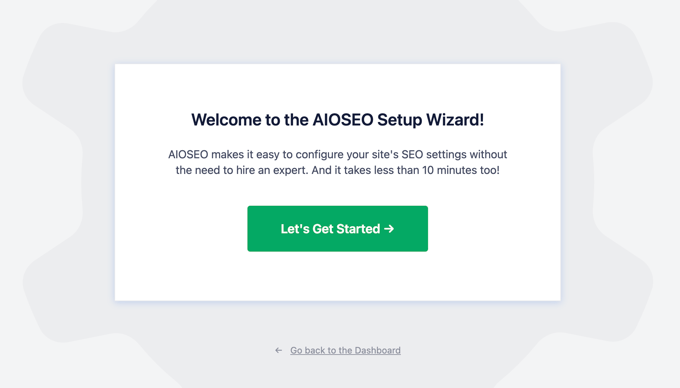
Det erbjuder kraftfulla funktioner som SEO-metabeskrivningar, konfigurerbara XML-webbplatskartor, fullt stöd för schemamärkning, integration med Google Search Console och mycket mer.
Det jag älskar mest med det är att det gör alla dessa tekniska SEO-saker enkelt och enkelt. Du behöver inte vara en SEO-specialist för att använda någon av dessa funktioner.
Om du är nybörjare på SEO rekommenderar jag starkt att du kollar in min kompletta WordPress SEO-guide, där jag steg för steg har visat den SEO-inställning som jag använder på alla mina bloggar.
2. Bygg upp en e-postlista
Om du frågar mig om det enda misstag som jag ångrar när jag startade mina bloggar, skulle jag säga att jag inte byggde en e-postlista direkt.
På den tiden hade SEO gjort underverk för mina bloggar, men det fanns ett problem. Användare som hittade min blogg via sökmotorer kunde bara lämna den, och jag hade inget sätt att nå dem.
Det var här jag upptäckte att jag behövde börja bygga en e-postlista. Det har varit det bästa beslutet för framgången för många av mina företag, inklusive WPBeginner.

Det gjorde det möjligt för mig att få direktkontakt med läsarna och få dem att återvända till bloggen. Om du är seriös med att öka din publik måste du börja bygga din lista idag.
För att komma igång måste du registrera dig för en e-postmarknadsföringstjänst. Dessa företag är specialiserade på att skicka massmeddelanden utan att utlösa skräppostfilter.
Jag använder Drip på WPBeginner. Det erbjuder många kraftfulla funktioner för att segmentera min publik och anpassa mina e-postmeddelanden. Dessutom fungerar det bra med andra tillväxtmarknadsföringsverktyg som jag använder.
Relaterat: Se varför jag bytte från MailChimp till Drip (Fallstudie).
Med det sagt kan det vara lite för avancerat för nybörjare, så du kanske föredrar att använda Constant Contact istället.
Och på tal om tillväxtmarknadsföring – du kan inte bara lägga till ett ensamt e-postregistreringsformulär i sidofältet på din blogg och hoppas att användarna ska registrera sig. Du måste vara smart och ge dina bloggläsare många alternativ för att gå med i din e-postlista.
Det enklaste sättet att göra detta är att använda OptinMonster. Det är den bästa programvaran för leadgenerering på marknaden och ger kraftfulla verktyg för att konvertera bloggbesökare till prenumeranter.
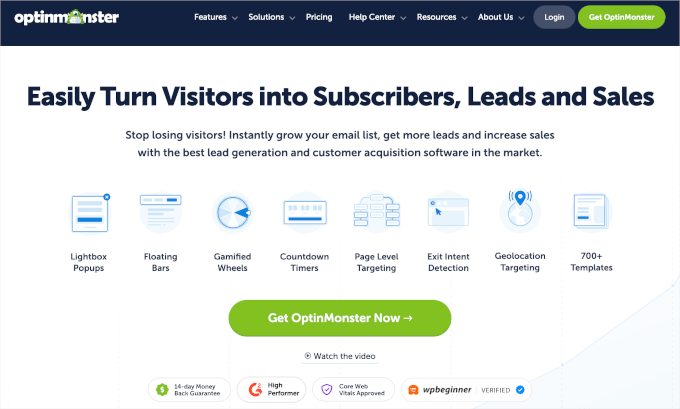
Det gör att du kan skapa vackra popup-fönster, slide-in-formulär, nedräkningstimer och mycket mer för att få användare att gå med i din e-postlista.
Jag har skrivit om alla de beprövade metoder jag använder på WPBeginner för att få vår e-postlista att växa, så du kan helt enkelt använda min strategi.
3. Använd push-meddelanden
En annan teknik som jag använder för att marknadsföra mina bloggar är “Push Notifications”. Det är anpassade meddelanden som du kan skicka som aviseringar till användarnas webbläsare på mobila och stationära enheter.
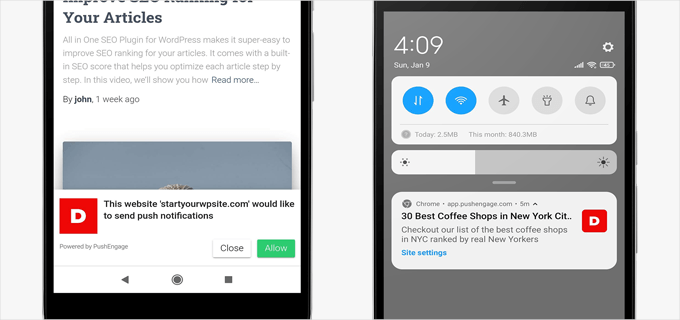
Push-notiser är ett utmärkt sätt att återengagera besökare efter att de lämnat din webbplats.
För att komma igång måste du registrera dig för en push-meddelandetjänst. För WPBeginner använder jag PushEngage, och det är nu en av våra bästa trafikkällor.
PushEngage är superenkelt att installera och levereras med kraftfulla funktioner som automatiserade aviseringar, personliga meddelanden, återhämtning av övergivna vagnar och anpassade optin-formulär.
För mer information, se min fullständiga PushEngage recension.
Mitt team har också sammanställt en steg-för-steg-handledning om hur du lägger till push-meddelanden i WordPress som du kan följa.
4. Utnyttja sociala medier för att bygga gemenskap
Sociala medier är en viktig källa till trafik och ett enkelt sätt att marknadsföra din nya blogg.
Men till skillnad från sökmotorer kräver sociala medieplattformar att man lägger ner tid på att bygga upp engagemang och räckvidd.
Lyckligtvis finns det verktyg som ClickSocial. Det gör att du kan schemalägga inlägg i sociala medier i WordPress. Det är bara att ställa in det, så kommer det automatiskt att publicera schemalagt innehåll till dina sociala medieprofiler.
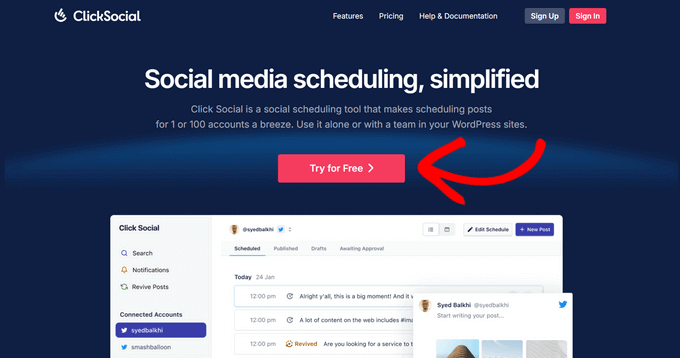
Sociala medieplattformar är dock en tvåvägsgata. Samtidigt som du vill få användare till din blogg, vill du också öka din följarskara på dessa plattformar.
Ett sätt att uppnå detta är genom att använda Smash Balloon. Det är det mest kraftfulla pluginet för sociala medier för WordPress och gör att du enkelt kan bädda in flöden från sociala medier på din webbplats.
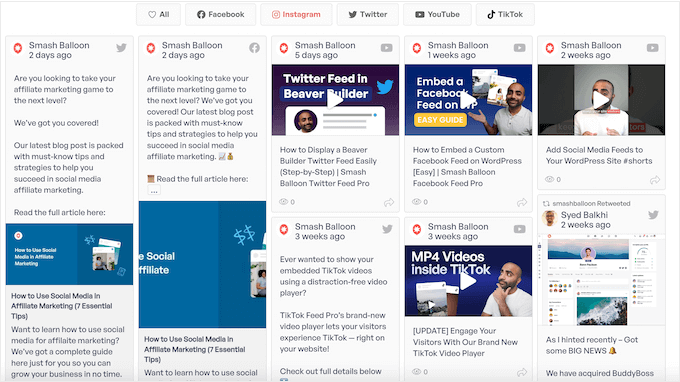
Smash Balloon fungerar med Facebook, Instagram, X (tidigare Twitter), YouTube och TikTok. Det har också ett tillägg för recensionsflöde, som gör att du kan visa recensioner från Google, Yelp, Facebook och mer.
Dessa strategier har varit de viktigaste källorna till trafik på mina bloggar. Men när du arbetar med din blogg kommer du att hitta andra sätt att marknadsföra och utveckla den. För några fler tips rekommenderar jag vår guide om hur du ökar din bloggtrafik.
En lärdom som jag har dragit genom åren är att tillväxt tar tid och kräver konsekvens, så jag uppmuntrar dig att alltid fortsätta att experimentera och lära dig.
Steg 8: Tjäna pengar på din blogg 💰
Oavsett om du skapar en blogg för att generera passiva inkomster eller helt enkelt som en hobby, hjälper intäktsgenerering dig att göra den hållbar på lång sikt.
Många bloggar som började som en hobby är nu sexsiffriga företag, till exempel Huffington Post, TechCrunch, Mashable och många fler.
På WPBeginner använder jag flera olika tekniker för att tjäna pengar för att göra bloggen hållbar och få den att växa till sin fulla potential.
Här är de bästa sätten att tjäna pengar på din blogg baserat på strategier som jag personligen har använt och rekommenderar.
1. Google AdSense
Ett av de enklaste sätten att tjäna pengar på din blogg är att visa annonser. Jag minns att jag lade till Google AdSense på en av mina tidiga bloggar, och det blev en enkel passiv inkomstkälla.
AdSense fungerar som en mellanhand som kopplar ihop dig med annonsörer som bjuder på sökord som är relaterade till ditt innehåll.
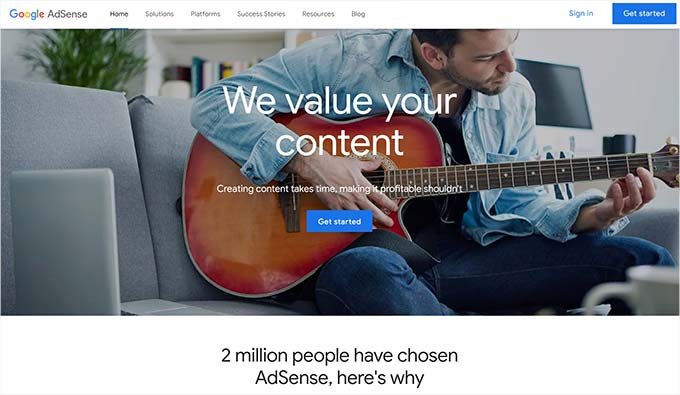
Om du vill prova AdSense har mitt team en steg-för-steg-guide om hur du lägger till Google AdSense i WordPress.
2. Affiliate-marknadsföring
Du kommer att märka en upplysning på WPBeginners artiklar om att vi tjänar en provision när du klickar på en länk. Detta kallas affiliatemarknadsföring och är en viktig inkomstkälla för många bloggar.
Det innebär att du rekommenderar produkter eller tjänster till dina läsare och att du får provision när de gör ett köp.
När jag startade WPBeginner fokuserade jag på att marknadsföra verktyg som jag personligen använde och litade på, vilket gjorde en enorm skillnad när det gällde att bygga upp trovärdigheten.
För att komma igång rekommenderar jag att du använder verktyg som Pretty Links eller ThirstyAffiliates för att hantera dina affiliate-länkar.
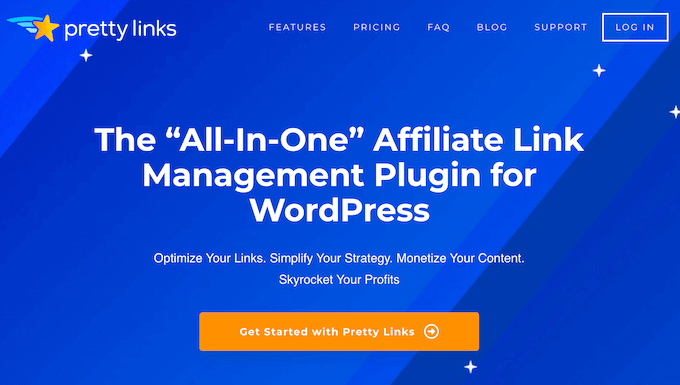
För detaljerade instruktioner kan du se vår guide för affiliatemarknadsföring för nybörjare.
3. Sälj produkter eller tjänster
Att sälja produkter eller tjänster är ett annat effektivt sätt att tjäna pengar. Oavsett om det handlar om fysiska produkter, digitala nedladdningar eller konsulttjänster kan du använda din blogg för att bygga upp ett företag.
För många av mina företag använder jag Easy Digital Downloads för att sälja digitala produkter och WooCommerce för fysiska produkter.
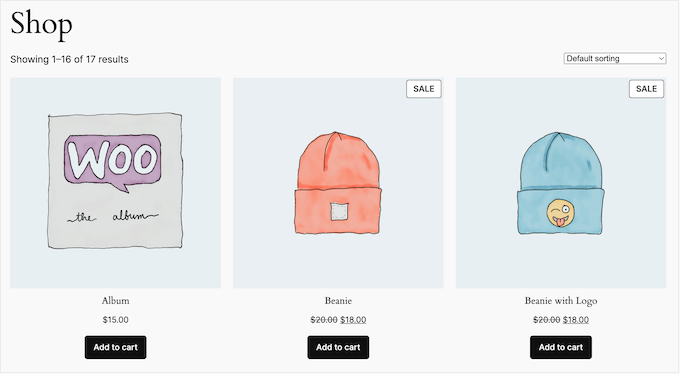
Om du är intresserad kan du kolla in mitt teams guider om att starta en webbutik och sälja digitala nedladdningar.
4. Sälj onlinekurser och prenumerationer
Ett annat populärt sätt att tjäna pengar på en blogg är att sälja premiuminnehåll eller erbjuda onlinekurser.
Du kan lägga en del av ditt innehåll bakom en betalvägg för betalda prenumeranter. Detta gör att du kan bygga en gemenskap samtidigt som du genererar tillförlitliga återkommande intäkter för din blogg.
Alternativt kan du erbjuda onlinekurser mot en avgift eller prenumeration.
Det enklaste sättet att göra detta är med MemberPress. Det gör att du enkelt kan begränsa innehåll, skapa prenumerationer och sälja onlinekurser.
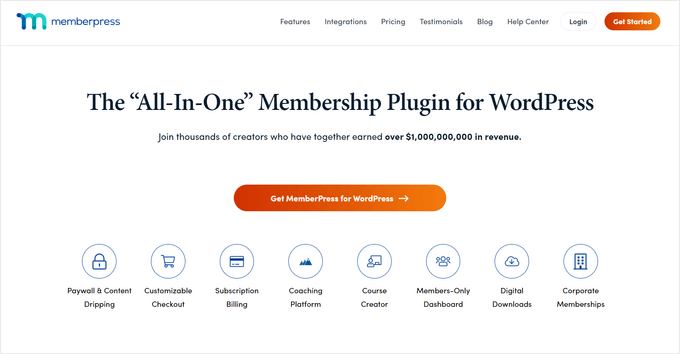
Jag använder MemberPress på WPBeginners webbplats för videokurser i WordPress. Jag tycker att det är otroligt enkelt att skapa kurser, lektioner och frågesporter och hantera prenumerationer.
För mer information, se min fullständiga recension av MemberPress.
Dessa strategier har hjälpt mig att förvandla mina bloggar till blomstrande företag.
Om du vill utforska ännu fler sätt att tjäna pengar på din blogg, läs då den här detaljerade guiden om sätt att tjäna pengar på din blogg. Kom ihåg att det inte finns några genvägar – hårt arbete och konsekvens är nyckeln till framgång.
Steg 9: Behärska WordPress
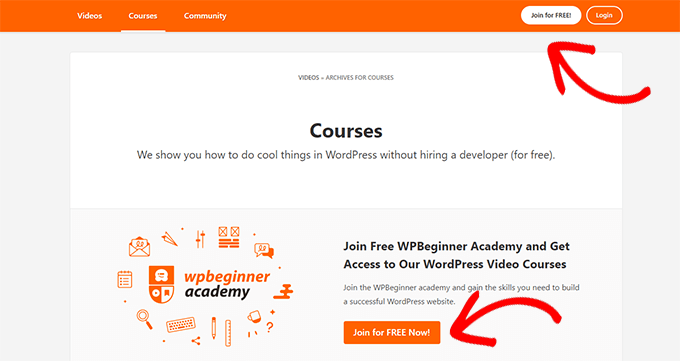
När jag började blogga fanns det väldigt få resurser för att hjälpa nybörjare att förstå WordPress.
Jag var tvungen att lära mig många saker den hårda vägen och spenderade ofta timmar på att felsöka enkla problem. Det är precis därför jag skapade WPBeginner – för att göra WordPress enkelt för alla.
Idag är WPBeginner den största kostnadsfria WordPress-resurswebbplatsen för nybörjare. Vårt uppdrag är att stärka småföretag, bloggare och icke-tekniska webbplatsägare med lättförståeliga handledningar och praktiska tips (se mer om oss).
För att utöka dina kunskaper om WordPress och ta din blogg till nästa nivå rekommenderar jag att du utforskar dessa resurser:
- WPBeginner Dictionary – När jag började kände jag mig ofta överväldigad av WordPress-terminologi. Därför har jag skapat denna nybörjarvänliga ordlista för att hjälpa dig att snabbt förstå WordPress-lingo.
- WPBeginner Videos – Våra gratis WordPress -kurser är perfekta för nybörjare. Vi bryter ner allt steg för steg, precis som jag önskar att jag hade gjort när jag började.
- WPBeginner Blog – Det är här du hittar alla våra WordPress-handledningar, från nybörjartips till avancerade guider. Det har varit min bästa plattform för att dela med mig av insikter och svara på användarnas frågor.
Att lära av andra är nyckeln till att bemästra WordPress. Jag uppmuntrar dig att gå med i vår kostnadsfria Facebook-grupp, WPBeginner Engage. Med över 98 000 medlemmar är det en fantastisk gemenskap där du kan ställa frågor, dela idéer och få kontakt med likasinnade bloggare och WordPress-användare.
Du bör också prenumerera på WPBeginners YouTube-kanal. Mitt team delar regelbundet videohandledningar där, som täcker allt från grundläggande inställningar till avancerade anpassningar.
Ett av de enklaste knepen jag delar med mig av till nya bloggare är att använda Google för att hitta svar. Skriv bara in din fråga i Google och lägg till “WPBeginner” framför den. Det här tricket hjälper dig att hitta våra guider snabbt, vilket sparar tid och frustration.
Om du fortfarande inte hittar något svar, tveka inte att höra av dig. Du kan använda kontaktformuläret för att skicka din fråga till mig. Jag är alltid glad att kunna hjälpa till.
Bonus tips: Utforska resurser för nischbloggning
Folk frågar mig ofta om vilket ämne de ska välja för sin blogg. Jag kan förstå att det kan vara svårt att komma på hur man ska sticka ut bland så många andra bloggar.
Jag har sett många nya bloggare som byter bransch och ämne i samma blogg. Att begränsa ditt fokus kan hjälpa dig att bygga en riktad publik redan från början.
För att hjälpa dig att utforska olika nischer har jag skapat en serie guider som visar hur du kommer igång inom olika populära bloggkategorier:
- Så här startar du en reseblogg – Resor har alltid inspirerat människor. Om du älskar att dela med dig av dina äventyr kan den här guiden hjälpa dig att omvandla din passion för resor till en blogg som skapar kontakt med läsare och ger dig inkomster.
- Hur man startar en matblogg – När jag ser matbloggar blir jag förvånad över hur ett recept kan ge upphov till så många samtal. Om matlagning är din passion visar den här guiden dig hur du delar recept och tjänar pengar på dina kulinariska färdigheter.
- Så här startar du en modeblogg – Från att dela med dig av klädidéer till att bygga upp en publik av modeentusiaster – den här guiden hjälper dig att skapa en blogg inom en av de trendigaste nischerna.
- Så här startar du en videoblogg (vlog) – Videoinnehåll blomstrar och att starta en vlog är ett kraftfullt sätt att få kontakt med din publik. Jag har sett bloggare förvandla videobloggar till blomstrande samhällen.
- Avslöjat: Vilka är de mest populära typerna av bloggar? – Om du är osäker på vilken nisch du ska välja kommer den här guiden att inspirera dig med exempel på populära och lönsamma bloggkategorier.
- Bästa bloggningsnischer – 7 som kommer att tjäna pengar (enkelt) – Jag rekommenderar ofta den här resursen till nybörjare. Den belyser nischer som inte bara är roliga utan också har stor intäktspotential.
Kom ihåg att börja med en nisch inte bara handlar om att sticka ut – det handlar om att bygga en gemenskap av läsare som litar på dig och kommer tillbaka för mer.
Jag har sett otaliga bloggare blomstra genom att fokusera på det de älskar och dela det på ett autentiskt sätt. Utforska dessa guider och se vilken nisch som känns rätt för dig.
Vanliga frågor om bloggning (FAQ)
Genom åren har jag svarat på otaliga frågor från nybörjare som precis har börjat sin bloggresa. Nedan följer svar på några av de vanligaste frågorna jag har fått. Jag hoppas att de hjälper dig att komma igång med självförtroende.
Kan jag skapa en blogg utan WordPress?
Ja, det finns andra bloggplattformar tillgängliga. Men enligt min erfarenhet är WordPress den bästa lösningen. Den erbjuder oöverträffad frihet och ägande, vilket är avgörande för att bygga en framgångsrik blogg. Det är därför jag alltid rekommenderar WordPress.
Kan jag bygga en blogg utan webbhotell?
Nej, webbhotell är viktigt. Webbhotell är den plats där din bloggs filer lagras. Det är som ett hem för din blogg på internet. Varje blogg behöver ett webbhotell och ett domännamn för att gå live.
Är det gratis att starta en blogg på WordPress?
WordPress-programvaran i sig är gratis, men du måste betala för webbhotell och ett domännamn. Om du har en snäv budget kan du börja med en gratis WordPress.com-blogg, men den har sina begränsningar. Jag förklarar dessa skillnader i vår guide om begränsningarna med WordPress.com och WordPress. com vs. WordPress.org.
Hur kommer jag på ett bra namn på en blogg för min site?
Många bloggar är uppkallade efter sin skapare eller det ämne de täcker. För inspiration rekommenderar jag att du provar vår AI-drivna företagsnamngenerator. Det är ett enkelt sätt att komma på kreativa och unika idéer till bloggnamn.
Vad är den bästa nischen för blogg?
Att välja rätt nisch är nyckeln till att sticka ut och hålla din blogg hållbar. Mitt team har sammanställt en lista över de bästa bloggnischerna och de mest populära typerna av bloggar. Dessa resurser kan hjälpa dig att välja en nisch som stämmer överens med dina intressen och har intäktspotential.
Hur mycket kostar det att starta en blogg?
Kostnaden beror på vilken hostingplan och vilka tillägg du väljer. Vi har skrivit en detaljerad guide om hur mycket det kostar att starta en WordPress-blogg, tillsammans med tips för att spara pengar. De flesta verktyg erbjuder kostnadsfria testversioner eller pengarna-tillbaka-garantier, så att du kan prova dem utan risk.
Kan jag starta en blogg och tjäna pengar med Google AdSense?
Ja, absolut. Google AdSense är ett av de mest populära sätten att tjäna pengar på bloggar. Det är enkelt att konfigurera och vi har skapat en guide om hur du lägger till Google AdSense i WordPress.
Kan jag skapa en blogg och förbli anonym?
Ja, det är möjligt. Du kan använda en pseudonym, ha WHOIS-sekretess aktiverat för din domän och undvika att dela personlig information eller foton. För mer information, kolla in den här guiden om hur du bloggar anonymt.
Var hittar jag bilder till min blogg?
Högkvalitativa foton förbättrar dina blogginlägg och ditt innehåll i sociala medier. Mitt team har sammanställt en lista med källor till gratis, royaltyfria stockfoton som du kan använda för att göra din blogg visuellt tilltalande.
Video Tutorial
För en fullständig visuell översikt över hur man startar en blogg kan du kolla in vår videohandledning:
Slutliga tankar
Att starta en blogg förändrade mitt liv på ett sätt som jag aldrig hade kunnat föreställa mig. Det började som en liten idé och växte till något som har hjälpt miljontals människor över hela världen.
Om du har följt den här guiden har du tagit det första steget mot att skapa något fantastiskt för dig själv. Gratulerar, gratulerar!
Kom ihåg: att blogga är en resa. Det kommer att finnas utmaningar, men med konsekvens, kreativitet och rätt verktyg kan du bygga upp något som verkligen påverkar.
Oavsett om ditt mål är att dela med dig av din passion, få kontakt med andra eller bygga upp ett företag kan din blogg vara grunden för otroliga möjligheter.
Mitt team och jag på WPBeginner finns här för att stödja dig varje steg på vägen. Om du har några frågor, behöver förtydliganden eller vill ha feedback på din blogg, tveka inte att höra av dig.
Lämna en kommentar nedan eller använd vår kontaktsida för att höra av dig. Jag skulle gärna vilja höra från dig!
If you liked this article, then please subscribe to our YouTube Channel for WordPress video tutorials. You can also find us on Twitter and Facebook.

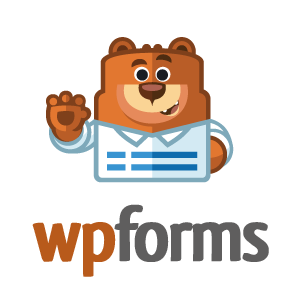
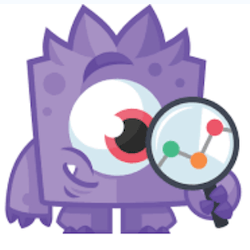

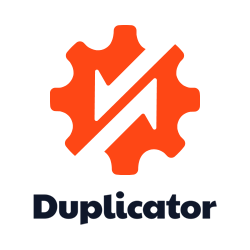
kzain
I’m going to start a blog this guide helped me a lot I always think of a plugin that would back up my WordPress theme so I guess I won’t get to start from scratch if something bad happens to my blog.
WPBeginner Support
We wish you luck with starting your blog, for backups we have a guide we would recommend below!
https://www.wpbeginner.com/beginners-guide/how-to-backup-your-wordpress-site/
Admin
Valery Teresa
The information is well written! Easy to understand making it easier to follow the steps. I appreciate.
WPBeginner Support
You’re welcome, glad our guide was helpful!
Admin
Chris
If a blog require users to login to view certain content, would it be necessary to write code?
WPBeginner Support
No, there are plugins you can use to set that up for you that would allow you to set it up without the need to use code directly
Admin
Mrteesurez
Yes, tools like Memberpress, Ultimate member, Paid membership pro and so on are easier to use for membership site where members sign in to view contents on your site, they do not require you write codes by yourself and have all contents locking features you need.
Hajjalah
I followed this article and successfully created my first blog on WordPress.org. I usually search this website if I face any issues on my blog and thankfully, I am always able to find a detailed article addressing the issues. I am now focusing on growing my website traffic.
WPBeginner Support
Glad to hear our guides are helpful!
Admin
Melody Mbewe
Thank you for this comprehensive beginner’s guide! Starting a WordPress blog can be daunting, but your step-by-step instructions make it approachable for anyone. From choosing the right hosting to customizing themes, this article covers all the essentials. Can’t wait to dive in and start my own blogging journey
Ahmed Moeez
that’s a Really Indepth and Practical guide. thanks, WPBeginner for providing this valuable information.
WPBeginner Comments
Glad that it was helpful!
Nusrath Alam
Hi, Your blog/website is very informative! Thank you!
I’m planning to start a new travel blog, and I have a question – do you recommend that the posts are written directly in the WordPress editor, or is it better to write several posts first in Word or something like that and then copy/paste or import them into WordPress before making it public? What’s the best way?
WPBeginner Support
There is no best way for writing at the moment, it would depend on your personal preference. The main advantage to using the block editor would be less editing your content to match the formatting from another editor.
Admin
Peter Iriogbe
Thanks for the content. But how do I manually use my custom domain and hosting server without buying through Bluehost? I have already installed WordPress on my PC. How do I do that? Please.
WPBeginner Support
It would depend on your specific host, for getting started we would recommend taking a look at our article below:
https://www.wpbeginner.com/beginners-guide/how-to-host-a-website/
Admin
Peter Iriogbe
Thanks for the time you use for putting up these pieces on this page. This is an A-to-Z guide on how to start a blog website and earn money. I recommend beginners follow the step by step mentioned in this article.
My little advice to a starter is not to focus on making money when you are just starting. While making money by blogging is cool, it should not be your main focus because if you do you might lose your commitment when your expectations are not met instead publish content as much as possible and optimize for a better ranking to get more traffic to your site. Afterward, look for ways to start making income from it.
Fajri
Wohoo, surely it is an ultimate guide for anyone who want to start their own blog.
No wonder why wordpress is the best CMS, especially for beginners.
Don’t rush the process in one night, bookmark this page and continue build your website later..
MOINUDDIN WAHEED
While starting out for a new blog the most confusing aspect is the outcome that we see is too much time taken. For years, sratching your head writing articles, posts and getting nothing. I had started a tech blog in 2017 and wrote articles for nearly one year. I couldn’t earn a single penny from that blog and consequently I left it. It seemed all my hardwordk went in vein with no tangible outcome.
Now when I see your posts and go through the minute details, I have a solid opinion now.
It takes time and also a planned practical roadmap. If that roadmap is followed I think it can be turned into full time job. Writing a blog post is tough. Finding a perfect niche is on the tougher side.
Is there a timeline of when our blog will start generating revenue?
WPBeginner Support
There is no specific timeline for when a site will start generating money but for a starting point we would recommend taking a look at our list below:
https://www.wpbeginner.com/beginners-guide/make-money-online/
Admin
Moinuddin Waheed
Thanka for the reply. I have gone through the link and found it to be very useful and practical steps to implement to make money online.
I am implementing all these tips and tricks on my website every passing day and hope to get its benefits one day.
Thanks for the inspiration.
Kabsha Majid
It’s both to-the-point and detailed at the same time. Just an awesome post.
WPBeginner Support
Glad you liked our guide
Admin
vahid fahimi
This was great. I just started and it was really helpful. Thank
WPBeginner Support
You’re welcome!
Admin
Ahmed Omar
This is an extraordinary detailed post about how to start
Thank you very much.
It will take time to go through all the related links
WPBeginner Support
You’re welcome, we hope you find our links helpful!
Admin
tushar
Very Helpful ! Clear all Picture
WPBeginner Support
Glad you found our guide helpful!
Admin
Farhad
How can I create a “community” page where my blog readers can discuss topics raised in my posts?
Thank you.
WPBeginner Support
For what it sounds like you’re looking for, we would recommend taking a look at our article below:
https://www.wpbeginner.com/plugins/how-to-turn-your-wordpress-site-into-a-social-network/
Admin
Dennis Munyao
I have been putting off my decision to own a blog for a long time but after reading your post, i feel ready to venture into blogging now.
WPBeginner Support
Glad we could help give you the confidence to start!
Admin
EMMANUEL
Am planning to start my website creating journey and i come across this site and with all these informations, thanks so much for all these knowledge. i appreciate.
WPBeginner Support
You’re welcome, we’re happy our guides are able to help get you started!
Admin
Jony
thanks a lot i appreciate that a lot
WPBeginner Support
You’re welcome! Glad our guide was helpful!
Admin
shivani singh
Thank you for giving us useful information
WPBeginner Support
You’re welcome!
Admin
Jervice Cj
Thank you, really helpful
WPBeginner Support
You’re welcome, glad to hear our guide was helpful!
Admin
Yogesh Singh
Nice article, but i have a question i am working on a website where i am posting articles everyday so it will be called blog or not because i am not using any wordpress and other platform?
WPBeginner Support
That would depend on the overall organization of your site, for a better understanding of what people mean when they say blog and website we would recommend taking a look at our article below!
https://www.wpbeginner.com/beginners-guide/what-is-a-blog-and-how-is-it-different-from-a-website-explained/
Admin
Brya Hamza
Very helpful
WPBeginner Support
Thank you
Admin
Matt Burn
Great guide this, I am definitely going to be using this when I start my blog properly tomorrow
WPBeginner Support
We hope our guide makes it that much easier for you!
Admin
Manish
Thank you for the information….it’s really useful.
WPBeginner Support
Glad our guide was helpful!
Admin
Nikhil Khunteta
Wonderful!! Thank you for posting the informative blog. Your posts are more interesting and informative.
WPBeginner Support
Glad you found our guide helpful!
Admin
zain ali
I am thinking of starting a blog. Reading this gave me a lot of great information as I am new to this. I plan on reading some of the links you added for more information on various topics. Thank you for having this here!
WPBeginner Support
You’re welcome!
Admin
Musa Rafiq
Thank you for the wonderful tutorial. This really helped me write my own first blog.
WPBeginner Support
You’re welcome, glad to hear our guide was helpful!
Admin
Melissa Millard
Thank you for this post. I am just being introduced to blogging in a course I am taking. We are using WordPress to create blogs. Honestly, I find the whole process a little intimidating. I appreciate you taking the time to walk beginning through the step to create a blog.
WPBeginner Support
Glad you found our guide helpful!
Admin
Khuliso Mashau
What an informative post. Thank you so much. I found this post just at the right time when I was struggling with setting up my WP.
WPBeginner Support
Glad to hear our guide was helpful!
Admin
Chris
Thanks for the super-informative article. I can see from other conversations here that it is possible to have the blog on a separate page within the website – presumably then I can use WordPress to create a whole website with many different features, e.g. a blog, a separate podcast, a page for showcasing my work portfolio, etc.? Would it also be possible to have more than one blog this way, i.e. for different types of content?
Thanks
WPBeginner Support
That can be done and the simplest way to implement it would be to use categories for your content and instead of a posts page, use the category pages for the individual blogs. The category pages work like the posts page but would only list the posts in that specific category.
Admin
Abigail
Thanks for the undiluted information on blogging.
My question is, is it possible to have a blog with two niches?
WPBeginner Support
It is possible to have multiple niches but it will be more difficult to rank well in search engines for multiple niches.
Admin
Farhad
How do I go from Coming Soon stage to have my site accessible on the Internet?
WPBeginner Support
You would normally only have a coming soon page if you have a plugin or tool that is adding that to your site. If you do then you would want to check the settings for the specific plugin you are using on your site.
Admin
Lorin Lopez
Hi, the video showed how to create a blog “post” as well as a separate “page” for my blogs titled “blog” but it didn’t show how to add my posts to that page? Like if I want all my posts to be available on display under the “blog” page on my menu option. is there a way to do that?
thank you!
WPBeginner Support
For that, you would set the blog page under Settings>Reading, for more on how to set this up, you would want to take a look at our article below:
https://www.wpbeginner.com/wp-tutorials/how-to-create-a-separate-page-for-blog-posts-in-wordpress/
Admin
Ivan
Hi,
can I have combination of blog and news aggregator website? I would like to have own posts on the top but some news from other websites below?
WPBeginner Support
You can certainly create a site like that if you wanted
Admin
Gadson
Thank you, this was so informative I am planning to start my own blog and I will use this same knowledge from this platform. But is it possible to create a blog that I can only see myself before paying for the host space. Please advise
WPBeginner Support
To have a local installation of WordPress before you invest in hosting, you would use a program like WAMP or MAMP on your computer. We have a guide on how to install WordPress on your computer below that can guide you:
https://www.wpbeginner.com/how-to-install-wordpress/#installlocal
Admin
Paul Morrison
On a blog site, is there not a way for users to subscribe to be automatically notified of new posts?
WPBeginner Support
To do that, you would normally want to look into using a newsletter. We have a guide on how to set that up below that should help:
https://www.wpbeginner.com/beginners-guide/how-to-create-an-email-newsletter/
Admin
evisionatlanta
I just found you on the right time. This is all I needed to start a blog. The very best informative tutorial I have found. Thank you
WPBeginner Support
Glad our guide was helpful
Admin
Ajoy
Then why is wpbeginner a .com and not a .org .
please let me know . And does the SEO make difference when using an .org or .com
WPBeginner Support
Our domain is .com as that is the most popular type of domain and is one of our recommendations in our guide on choosing a domain below:
https://www.wpbeginner.com/beginners-guide/tips-and-tools-to-pick-the-best-domain-for-your-blog/
If you mean .com in terms of WordPress.com instead of WordPress.org then your domain’s end does not determine if it is a .com or .org site
Admin
Gamaliel
Helo WPBeginnner
Is your blog special still running? The one where I pay for hosting with one of your partners and you build a blog for me
Ameerah
This was really very much helpful. being new to wordpress i felt a little too anxious but after this i am known to everything.
thanks!
WPBeginner Support
Glad you found our guide helpful
Admin
Lisa Keene
Thank for this information. I really enjoyed the blog and made plenty of notes. I hope for them to become useful. Please continue to provide for your readers.
WPBeginner Support
Glad you found our guide helpful
Admin
Sathish S
This is a get to go guide. One of the detailed post that helped me gain more insights and I’m recommending this post to my circle as well.
Keep up the good work.
WPBeginner Support
Glad our guide was helpful
Admin
Muhammad Fahad Zahid
Wow! Thanks for an amazing guide! I have just started my new blog after following the instructions on this post! Hope everything goes right
WPBeginner Support
Glad our guide was helpful and we wish you good luck with your site
Admin
mugie
Thanks for the article @Wpbeginner.
Isn’t it better to build a whole website and only have a section of ‘blog’ as a page for writing your blogs
from what I read it felt like it would almost cost the same to buy a domain name and host a website to having just a blog?
WPBeginner Support
It sounds like you may have some confusion on blogs vs websites, you can see our guide on this in our article below:
https://www.wpbeginner.com/beginners-guide/what-is-a-blog-and-how-is-it-different-from-a-website-explained
Admin
James Kendall
Hello WPBEGINNER SUPPORT..!!
Very nice blog you are created. Highly Appreciate for this.
WPBeginner Support
Glad you like our content
Admin
Michael
I started out my blog 2 weeks after reading this post. It has been so, so, helpful. Bless you!
WPBeginner Support
Glad our guide was helpful
Admin
Mike Crutcher
How can post a “Table Of Contents” or listing of all of my Blog Posts? Can I make them searchable for the reader? I currently can only see recent posts. Should I add another page to my site with a list of the past Blog Posts?
WPBeginner Support
It sounds like you mean a blog page, by default you would have your posts appear on the home page but you can follow our guide below to create a blog page:
https://www.wpbeginner.com/wp-tutorials/how-to-create-a-separate-page-for-blog-posts-in-wordpress/
Admin
Rachel
Hello, if I change my blog domain name after 2 years ,does it affect my ranking though I have very few page visits on my wordpress site
WPBeginner Support
You would want to take a look at a different article of ours linked below:
https://www.wpbeginner.com/wp-tutorials/how-to-properly-move-wordpress-to-a-new-domain-without-losing-seo/
Admin
Michael Adebayo
Can I create a blog without using any page builder such as elementor?
WPBeginner Support
Yes, you can
Admin